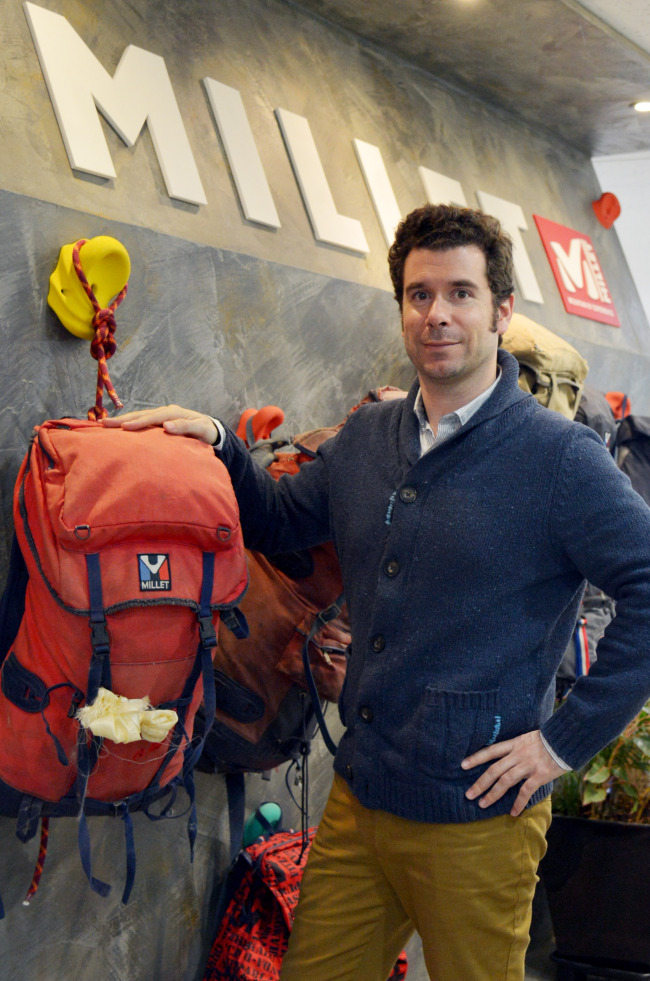‘Korea saved European outdoor brands’
Executive at Millet upbeat as outdoor market here shows explosive growth
By Korea HeraldPublished : April 22, 2013 - 19:49
European outdoor wear and equipment brands such as Millet of France were hanging by a thread when demand in Korea began to jump over 30 percent each year as hiking became fashionable and hikers started to dress up.
“Due to strong nationalism in terms of the brands and differences in tastes and sizing, the European market is very fragmented, meaning the French only buy Millet and the Germans only buy Jack Wolfskin,” Julien Provot-Ragueneau, senior executive officer at MilletEdelweissHoldings, said in an interview with The Korea Herald.
“It was hard for European outdoor companies to grow big. Most went global only five to eight years ago, and with the EU facing a deeper crisis, the outdoor market in Europe grew only two to three percent.”
“Due to strong nationalism in terms of the brands and differences in tastes and sizing, the European market is very fragmented, meaning the French only buy Millet and the Germans only buy Jack Wolfskin,” Julien Provot-Ragueneau, senior executive officer at MilletEdelweissHoldings, said in an interview with The Korea Herald.
“It was hard for European outdoor companies to grow big. Most went global only five to eight years ago, and with the EU facing a deeper crisis, the outdoor market in Europe grew only two to three percent.”

The only way of expanding was to go to Asia since growing in the U.S., already dominated by homegrown brands like The North Face and Columbia, was “nearly impossible” as the world’s largest market required a completely different business organization to have a logistics system that could cover from the east to the west coast, the French executive said.
Millet Inc., a Korean company run by Han Chul-ho, bought the trademark Millet for the Korean and Chinese markets in 2009 from French-based Lafuma Group. Financially distressed Lafuma sold two other brands to Korean firms that year ― Lafuma to LG Fashion and Eider to K2 Korea.
Currently, most of Millet’s sales come from Korea. Revenue in the country is much bigger than the combined revenue from the rest of the world.
Despite the high prices of products, which are about 30 percent more expensive compared to in the U.S., the outdoor market here is expected to grow another 11 percent to some 6.4 trillion won ($5.7 billion) this year after jumping more than 160 percent over the past four years.
“The Korean market is saving European outdoor brands,” said Provot-Ragueneau, who came to Korea in January to join both Millet Inc. and MEH, which imports Italian outdoor brand Napapijri.
The Paris native who worked for Lafuma Group for 12 years in Hong Kong, Tokyo and Shanghai moved to Seoul because of the massive growth of the Korean market.
“Millet in France doesn’t want to become a fashion brand. It chose to remain true and pure to the mountaineering activity. They keep certain products even if it is heavy,” he said.
“But the Millet collection in Korea has a tiny line for pure mountaineers who represent a small percentage of the customers here. We import these items from Millet France. Eighty percent of the products for the Korean market are designed and developed in Korea.”
Millet Inc. collaborates a lot with Millet in France. It sends teams to France six times a year to exchange information on consumer trends and give them input on what to design.
“While Millet belongs to a Korean company, the brand’s DNA is still French,” the executive said.
Outdoor brands in Korea usually have three product segments ― for mountaineering experts; for trekking, rock climbing, mountain bikes, camping and travel; and for daily fashion.
Provot-Ragueneau is in charge of Napapijri, an Italian premium casual brand which MEH started importing in September last year.
“Founded in 1987 in Italy, the brand concept was about North pole expedition gear. Napapijri means Artic Polar Circle in the Finnish language and is also the name of a small village located on the Polar Circle,” he said.
The brand became trendy in Europe for its high-end winter and ski collections, and has gradually widened its collection range to women and kids, summer as well as bags and shoes.
Napapijri was purchased in 2004 by VF Corporation, which has The North Face, Vans, Kipling brands, and since then expanded its retail network up to 2,500 points of sale in Europe.
After Japan, Korea is the second market in Asia to distribute Napapijri, with two stores in Apgujeong and Shinsegae Centum City. Five more stores are planned for 2013.
“We believe Napapijri has a great potential in Korea since the market trend has switched from formal casual wear to more open-minded and stylish wear,” Provot-Ragueneau said.
“Napapijri offers a complete outlook coordination, or a total look by mixing colors and styles, from jacket, sweater, shirt or polo to pants or shorts, shoes and bags. The products come in various themes and lines per season, color codes that give consumers several options and constant renewals.”
By Kim So-hyun (sophie@heraldcorp.com)
-
Articles by Korea Herald





![[Graphic News] Number of coffee franchises in S. Korea rises 13%](http://res.heraldm.com/phpwas/restmb_idxmake.php?idx=644&simg=/content/image/2024/05/02/20240502050817_0.gif&u=)



![[Robert J. Fouser] AI changes rationale for learning languages](http://res.heraldm.com/phpwas/restmb_idxmake.php?idx=644&simg=/content/image/2024/05/02/20240502050811_0.jpg&u=)








![[Eye Interview] 'If you live to 100, you might as well be happy,' says 88-year-old bestselling essayist](http://res.heraldm.com/phpwas/restmb_idxmake.php?idx=652&simg=/content/image/2024/05/03/20240503050674_0.jpg&u=)
